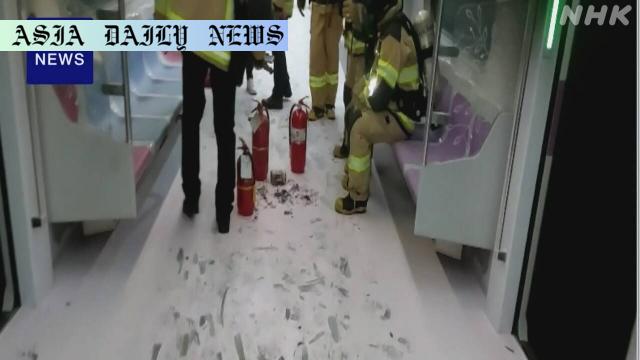Seoul subway fire disrupts service with 21 passengers hospitalized and hundreds evacuated after man allegedly ignites blaze.

Man Detained for Allegedly Starting Fire in Seoul Subway
In a deeply unsettling event, South Korea police detained a man in his 60s for allegedly setting a fire inside a subway train in Seoul. The alarming incident took place on a Saturday morning at approximately 8:40 a.m. As reported by Yonhap News Agency, the suspect boarded the train carrying a fuel container and reportedly set fire to pieces of clothing. The motive behind this troubling act remains under investigation.
Emergency Evacuations and Hospitalizations
The fire led to emergency measures, as about 400 passengers were evacuated from the train amid the chaos. Tragically, 21 individuals were rushed to hospitals due to smoke inhalation and other related injuries. Witnesses recounted the tense moments inside the train, as the fire caused panic among passengers.
The subway operator suspended services temporarily to secure public safety. As the flames engulfed parts of the train, authorities worked tirelessly to extinguish the blaze, which took approximately 90 minutes to bring under control. This closure significantly disrupted daily commutes in one of the busiest cities in Asia, underlining the critical importance of ensuring passenger safety in urban transit systems.
Investigation Into the Motive Behind the Incident
Following the suspect’s detention at a nearby station, police launched an in-depth investigation to uncover the reasoning and details of the incident. Authorities are exploring various angles, including the suspect’s mental health, possible grievances, and intent. Incidents like this highlight both vulnerabilities in public transportation systems and the need for heightened security protocols to prevent such occurrences.
Public Reaction and Broader Implications
The incident has left Seoul residents rattled, with many calling for stricter security in public spaces. Urban transit systems worldwide are under growing scrutiny given their vulnerabilities to accidents or deliberate sabotage. While South Korea’s subway system is praised for its efficiency and safety standards, incidents like these underline the need for constant vigilance and the implementation of safety measures such as routine bag inspections or advanced surveillance technology.
As details continue to emerge, it remains imperative to address both the short-term and long-term challenges posed by such incidents. Immediate support for the victims and steps toward bolstering public safety will be crucial in restoring confidence and preventing recurrence.
Commentary
Reflections on the Seoul Subway Incident
The recent fire incident in the Seoul subway is a sobering reminder of the delicate balance between ensuring public safety and the unpredictability of human behavior in shared spaces. As urban centers continue to grow, transit systems have become lifelines for millions of daily commuters. However, incidents such as this underscore their vulnerability and the complex challenges that come with safeguarding them.
The Importance of Emergency Protocols
One commendable aspect amidst the chaos was the swift response from emergency services and the subway operator. Successfully evacuating 400 passengers in a crowded metro environment is no small feat. Moreover, the presence of protocols undoubtedly saved lives and limited the extent of injuries. Yet, there is room for reflection on how preventive measures can further be enhanced.
Balancing Convenience and Security
The need to maintain open, accessible public transit systems while ensuring security is a challenge faced by cities worldwide. Unrestricted access makes metro systems a target for both accidents and deliberate actions. How can authorities strike a balance? Simple actions like bag checks or thermal scanners could be effective deterrents but may spark debates over privacy and inconvenience. However, ensuring passenger confidence should remain a priority as incidents, even few and far between, can have long-lasting effects on user trust.
Lessons for the Future
Finally, this incident offers a chance to assess current safety protocols and implement improvements. Better awareness campaigns, reinforced surveillance, and faster response mechanisms are essential for urban transit resilience. Moreover, reviewing mental health outreach programs could also identify individuals in distress before tragedies unfold. The Seoul subway fire should be a turning point for public transport operators globally to take proactive steps that blend safety with accessibility.


